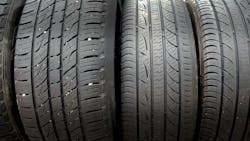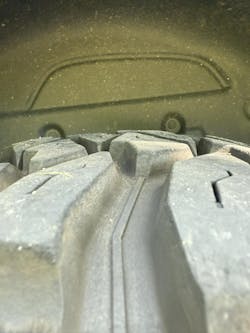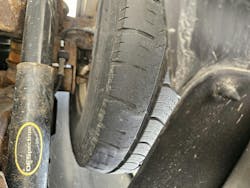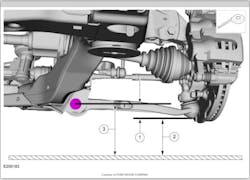Understanding tire wear patterns: A guide to diagnostics and shop growth
Key Highlights
- Recognizing abnormal tire wear patterns such as feathering, camber wear, and cupping can reveal underlying alignment and suspension issues.
- Effective communication and digital inspection tools are essential for diagnosing problems, educating customers, and increasing sales opportunities.
- Tire wear should be viewed as a diagnostic clue and a business opportunity, not just a reason for replacement.
Nobody likes to buy tires. To add insult to injury for the vehicle owner, all too often tires are being replaced not because they have come to the end of their service life, but rather something has gone amiss, and they have prematurely worn to the point they are no longer safe or comfortable to drive on. That is where there is an opportunity for the technician and shop owner to come in, remedy the underlying issue, become the hero for the customer and realize revenue.
When Opportunity Rolls Away
It's all too often a vehicle comes into a shop with abnormal tire wear and an opportunity is missed. A customer discovers abnormal wear, only seeing the worn tread but not knowing what they are looking at. They think it must be time for a new set of tires, and they look at some pricing online and then make an appointment. The tires are replaced by a general service or tire technician. Once changed, the customer is sent on their way not knowing that they are probably destined to repeat the process in the not-too-distant future. They are sent on their way without anyone at the shop outside of a general service technician getting their hands on the car and seeing those tires up close. When that happens, all of that opportunity drives away.
Tire Wear Tells a Story
Tire wear, especially abnormal wear, does not occur in a vacuum. Experienced technicians, service advisors, and other industry personnel typically can look at a worn set of tires and quickly come up with a hypothesis on what caused that wear. But that ability comes with experience, and often it’s the least experienced in our industry who perform most tire services. The natural progression of a technician’s career has him or her starting out performing these basic services. Fluid and filter services, tire, and TPMS service are a great way to build new technicians’ skills and confidence at the beginning of a career. But a big part of progression and growth is educating new technicians on what to look for, especially when it comes to critical componentry like tires. It keeps that growth arc moving, keeps customers safe and satisfied, and maximizes sales opportunities for the business.
Common Tire Wear Patterns
Even to the untrained eye, things like camber wear, cupping, and feathering can easily be detected. Experience is being able to take that visual cue and associate it with what the cause might be. This is where the growth comes in for the newer members of the team. So, let’s review some of these common wear patterns, and some of the opportunities they present for the shop. I am going to start off with one of the most common wear patterns, and that is feathering.
Feathering is exactly what the name implies and it is caused by excessive positive or negative toe. Feathering can be detected across the tire and presents itself as a feathered edge on the inside or outside of a tread block. This wear occurs because of the scuffing action the tire experiences as the tire scrapes across the pavement. The more excessive total toe deviates to the positive or the negative, the more exaggerated the feathering will be. Because feathering occurs due to toe changes, and toe is affected in varying degrees by changes in camber and caster, the primary cause of the incorrect toe angle can vary greatly. Anything from bent components, loose inner and outer tie-rod ends, to worn out springs that have degraded ride height can end up being the root cause of the condition. But the presence of feathering is a key indicator that something affecting the alignment of that vehicle needs to be addressed.
Camber wear is another prominent tire wear condition that shops see daily. Camber wear is found on the tread block nearest the shoulder of the tire. It can appear on the outer edge of the tire, for instances of positive camber. Or more commonly on modern suspension designs, the inside of the tire, indicating excessive negative camber. Just like the feathering mentioned above, it can be caused by a myriad of reasons, but loose wheel bearings, ball joints, and again degraded ride height are amongst the highest offenders. Now it should be mentioned that abnormal wear on both the inner and outer edge of the tire should be taken as an indication of underinflation. TPMS has been around for so long now that many technicians take for granted that tire pressure is something that is addressed immediately by the vehicle owner, but never underestimate a person’s ability to drive extended periods of time while ignoring all sorts of malfunction indicator warnings on the dashboard and all the bells, chimes, and pop-up messages that can go with them.
Tire cupping or scalloping is another tire wear pattern that is commonly seen and in this instance, heard by technicians and vehicle owners. Tire cupping is observed as dips, or “cups” around the tire tread surface. This effect, depending on severity, can be very noticeable by the customer, often accompanied by a noise complaint. And just like camber and tow wear, can have its root cause be several offenders, but taking a hard look at ride control components is a great place to start. The primary function of a shock or strut is to control spring oscillation and keep the tire firmly in contact with the road surface. As the oil found in the shock or strut degrades or leaks out, its ability to work properly is compromised. Not only will ride quality and handling/braking ability of the vehicle be reduced, but the tire that at one time was consistently loaded and planted on the pavement now has the ability to move around — for lack of a better term. This can cause the tire to scallop and wear unevenly.
Feathering, edge wear, and cupping are far from the only tire wear issues a technician will come across, there is center wear from prolonged overinflation (or the spirited use of the throttle in the quest to transform rubber into smoke), cracked tires from age and dry-rot. Plus some tires come to the end of their useful life due to nothing more than normal use. But the former are the wear items most closely associated with worn parts and alignment issues. We have identified the issues, now what actions should be taken with that information? That is where the communication portion becomes important.
Communication Is Key
As we talked about in the beginning, if there is a breakdown of communication within the shop, opportunities for additional revenue will be missed, and just as importantly we are sending customers out the door with an expensive new set of tires that are not going to last as long as they should because of an underlying vehicle issue. It’s not unheard of in even medium sized operations for the person who is installing a set of tires to be different than the person performing a majority of the alignments. And both of those people can be different from the person who does a lot of the undercar work. Building a culture of communication and mentorship will pay off. Think of it like TSA: If you see something, say something. That “green” general service technician should feel empowered and given the time to perform a thorough inspection of the customer's vehicle.
Digital Inspections Are the New Normal
Just like everything in the automotive industry, inspection technology has evolved. The traditional inspection sheet filled with green, yellow, and red boxes that offer very little insight for the customer are often woefully out of date with modern vehicle technology. Because of this, the sheets are often simply pencil-whipped by the technician. These forms have fallen out of favor for modern digital vehicle inspection (DVI) technology. DVI platforms allow technicians of all levels to digitally document the condition of vehicle systems and attach photo and video documentation to support their findings. These reports are easily attached to work orders, estimates, and shared with every stakeholder in that vehicle’s repair journey. Many of the popular shop management systems work seamlessly with DVI platforms on the market today. If your shop is not currently using a DVI solution, I highly encourage you to do some more research on the subject and look at some of the options on the market.
I have long felt that tires are the easiest way to sell undercar and ride control components. It’s much easier for a vehicle owner to make the connection between tire wear and worn parts when the vehicle is in for that tire service. Armed with the tire evaluation and their findings from a thorough inspection of the rest of the vehicle, the technician has most of what they need in order to communicate effectively with the front of house staff to get an accurate estimate on what the vehicle needs. The last piece of that puzzle is the recommendation of corrective measures to get that vehicle back in proper alignment to keep that customer on the road longer with the new set of tires.
Tire wear issues rarely occur in isolation. For example, if both front tires show accelerated camber wear on the inside edges along with feathering, it suggests a combination of excessive negative camber and toe. Feathering alone might point to a toe problem, but when paired with camber wear, the root cause likely involves components affecting both angles. Worn ball joints, hub assemblies, and control arm bushings are common culprits, but if an inspection has ruled those out and the wear is uniform, the technician should consider one often overlooked factor, ride height.
Don't Overlook Ride Height
Vehicle ride height, depending on suspension design, can be a key contributing factor to tire wear concerns and is often completely overlooked by technicians. Two of the more common styles, McPherson and short, long arm suspension styles, because of their design, will induce a change in camber angle (and in turn toe as well) as the vehicle’s ride height changes. More often than not, this is an education of ride height due to worn springs, but it can just as easily be because of new ride control restoring factory ride height or even a leveling kit in a pickup. Springs wear and settle; linear or progressive coil, torsion, leaf — there isn’t a spring design immune to this. And if the suspension design dictates there will be a change of alignment angles with this change of ride height, it’s something a technician needs to keep front of mind.
The nice thing about ride height is it’s a great way to demonstrate to a customer the need for ride control products that will restore these critical angles. Simply using the alignment machine, then sliding air over hydraulic jack found on my most drive on hoists, and a few photos are an excellent way to drive additional revenue. Often bumping a vehicle up a bit to its original ride height will bring those camber, caster, and toe angles pretty darn close to where they need to be. It’s a great way to demonstrate to the customer how investing in ride control products will help prolong that expensive new set of tires they had to purchase. Because the degradation in ride height is not going to improve, and even if there is enough adjustment left, the vehicle is only going to fall back out of alignment quickly.
When looking at ride height and tire wear, a technician always needs to be on the lookout for clues of tire wearing conditions that are not always super obvious. Spending the majority of my adult life in Minnesota, two key realities about the colder months set in very quickly for me. First, the professional football team that resides here will always find new and inventive ways to rip the hearts out of the fan base. Second, dealing with white, fluffy, frozen precipitation is an ever-present reality for the better part of half the year. Many trucks and SUVs in northern climates drive significant miles with heavy plows mounted on the front of the vehicle. Depending on suspension design, that weight can have a significant impact on tire wear. Since the late 1980s GM used an independent front suspension design, Ford has had their Twin I Beam and later a SLA design in the half-ton trucks, so ride height changes are a concern. Ford Super Duty and Ram have held firm with a solid axle design, so ride height is not as much of a factor. But if you notice abnormal tire wear and a plow mount on an independent front suspension vehicle, it is worth the conversation with the customer to inquire about the amount of time that vehicle is driven with a plow on it. If it’s significant, it may be worth the effort to align the vehicle with the plow on it. If it’s an older model truck that is still using torsion springs, even making a ride height adjustment with the plow hanging can significantly improve tire life on those vehicles.
Use Tires as a Teaching and Revenue Tool
Tire wear should never be treated as an isolated issue but rather a conversation starter, a diagnostic clue, and a business opportunity. By encouraging communication between technicians, advisors, and customers, and by empowering even entry-level techs with knowledge and confidence, shops can avoid missed opportunities, keep customers safe, and boost revenue. The goal is simple: Don’t just replace the tire but solve the problem that ruined it. That level of thoroughness builds trust, improves retention, and ultimately transforms routine tire service into a critical part of your shop’s success story.
About the Author
Erik Screeden
Technical and Multimedia Content Director
Erik Screeden is the Technical and Multimedia Content Director for the Vehicle Service & Repair Group. Erik is an ASE Master Automobile Technician with L1, and L4 credentials, who has been in the industry for over 25 years in various capacities. During that time, Screeden was a technician. He started out at a Ford dealership and continued to several independent repair facilities as well as spent time in the specialty aftermarket at a GM-specific performance shop. After his time as a technician came to an end, Screeden transitioned into a role providing scan diagnostic and J2534 tool support. He was then able to parlay his experience as a technician and a support specialist and use that in several technical sales roles.
Don't miss any of Screeden's video content sign up for Autoplay.




